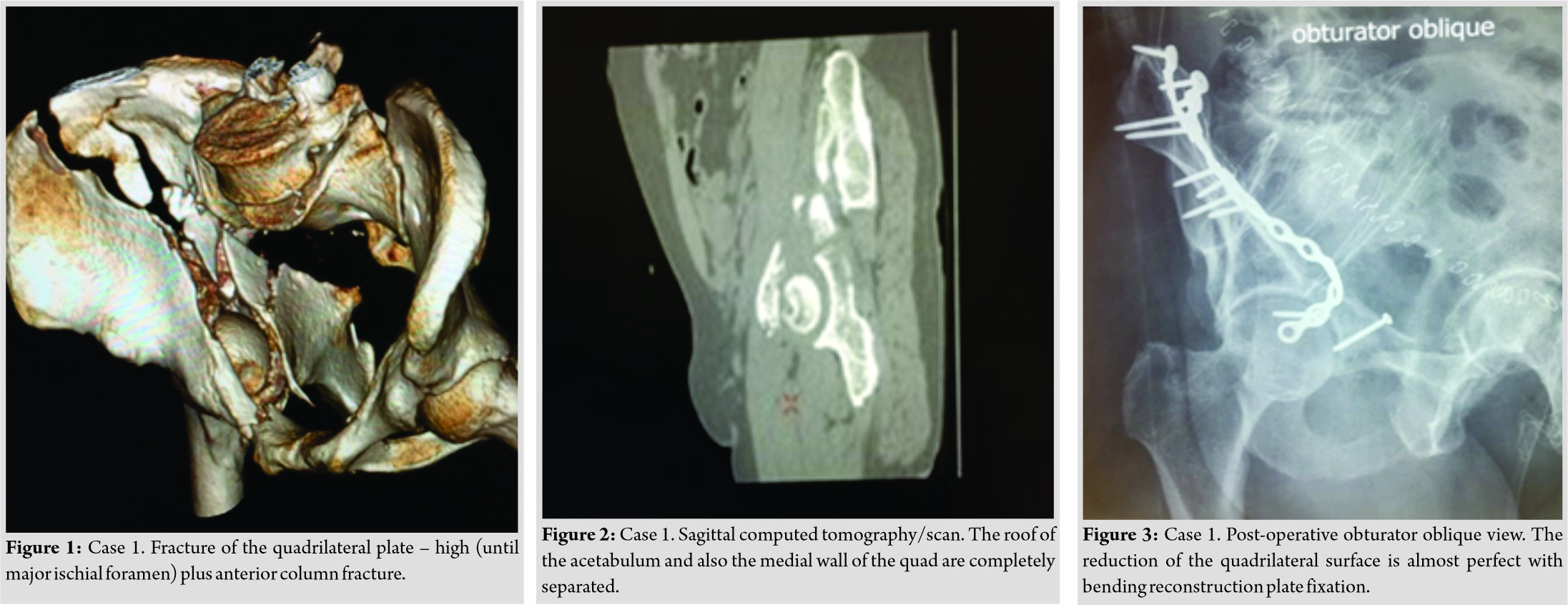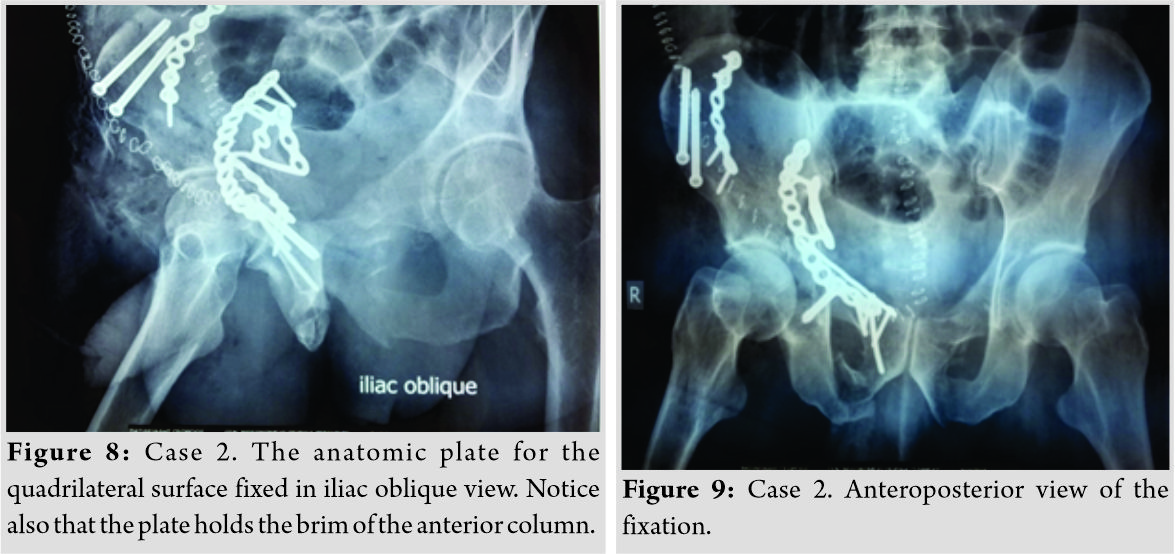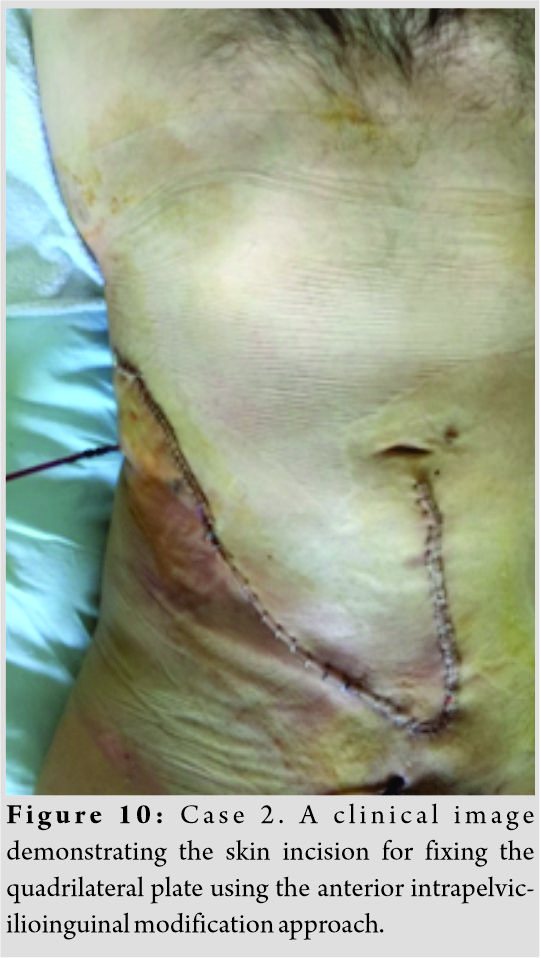[box type=”bio”] Learning Point of the Article: [/box]
Reduction and fixation of the anterior pelvic column and the quadrilateral plate of the acetabulum fractures can be treated successfully with the use of Anterior Intrapelvic Approach – ilioinguinal modification. The use of the anatomical suprapectineal plate system offers more stable osteosynthesis and reduces the operating time avoiding the use of multiple reconstruction plates. However the placement of this anatomical plate makes the Anterior Intrapelvic Approach imperative.
Case Report | Volume 10 | Issue 1 | JOCR January – February 2020 | Page 78-81 | Fotios V Nikolopoulos, Nikolaos T Tzoras. DOI: 10.13107/jocr.2020.v10.i01.1646
Authors: Fotios V Nikolopoulos[1], Nikolaos T Tzoras[1]
[1]Department of Orthopaedic Surgery, General Hospital of Piraeus “Tzaneio,” Zaniand Afentouli 1, Piraeus,Greece, 18536.
Address of Correspondence:
Dr. Fotios V Nikolopoulos,
Department of Orthopaedic Surgery, General Hospital of Piraeus “Tzaneio,” Zani and Afentouli 1, Piraeus, Greece, 18536.
E-mail: nikoped@gmail.com
Abstract
Introduction: Two similar pelvic fracture cases were both treated with the new anterior intrapelvic (AIP) approach (modified Stoppa approach)-the ilioinguinal modification. The traditional reconstruction plate is used in case 1 and the new special designed anatomical quadrilateral plate (the suprapectineal edition) is used in case 2. The two cases are discussed in terms of surgical difficulty, surgical time, blood loss, patient recovery, stability of the osteosynthesis.
Case Report: Two similar cases according to the classification of Judet-Letournel acetabulum fractures were chosen. Case 1 is a male 55 years old, injured in a motor vehicle accident who had a pelvic fracture, especially a quadrilateral surface fracture in conjunction with high anterior column fracture. Case 2 is also a male 58 years old, who fall from height, had almost the same fracture type according to Judet-Letournel classification. The traditional reconstruction plate was used in case1 and the new anatomical suprapectineal plate system was used for internal fixation in case 2.
Conclusion: The application of the new suprapectineal plate system (anatomical plate) as seen in case 2 is not possible through the ilioinguinal approach only. The use of AIP is imperative for the fixation of the quadrilateral surface fracture using these anatomical plates. The combination of the AIP with the lateral window or the first two windows of ilioinguinal approach gives excellent access to the true pelvis and the ilium in the high anterior column fractures.
Keywords: Pelvis fracture, quadrilateral surface, anterior intrapelvic, Stoppa, suprapectineal plate.
Introduction
Pelvic fractures (and acetabulum) are very serious high-energy injuries sometimes life threatening. In bibliography, there are series of 3471 acetabulum fractures in 3434 patients (23 publications) [1, 2, 3, 4]. There were 3561 males and 1396 females with male-to-female ratio 2.5:1 or 71.8% versus 29.2%, respectively [5]. The mean age was 33.6 years old with fluctuation 7–106 years old. Motor accident was the main cause of these injuries in 79.2%, a simple falling in 8.5% and 5% other causes. About51.2% had multiple trauma injuries and 23.5% had traumatic brain injury. Data from German multicenter studies give 50.6% individual acetabulum fractures, 32.4% had one additional injury, and 17% had multiple injuries. The left acetabulum is more common than the right one. Mortality has been estimated to 3%. The ilioinguinal approach was the workhorse approach in the treatment of displaced acetabular and pelvic fractures during the past decades [6]. The anterior intrapelvic (AIP) approach is lately the preferred surgical approach for the quadrilateral surface and anterior column fractures fixation. The AIP is based onthe initial Stoppa approach for hernias [7]. Stoppa approach was modified and developed from Cole and Bolhofner [8] for the acetabulum fractures. The current clinical practice for fixation, is the use of reconstruction plates. However, for these special types of the quadrilateral surface fractures of the pelvis, nowadays, a new type of anatomical plates has also been developed. The scope of the manuscript is to present two similar pelvic fracture cases both treated with the new AIP approach (Stoppa approach)-the ilioinguinal modification. The traditional reconstruction plate is used in case 1, whereas a new specially designed anatomical quadrilateral plate (the suprapectineal edition) is used for internal fixation in case 2. The two cases are discussed in terms of surgical difficulty, surgical time, blood loss, patient recovery, and stability of the osteosynthesis.
Case Report
From a number of operated pelvic fractures, two similar cases according to the classification of Judet-Letournel were chosen. Case 1 is a male 55 years old, with motor vehicle accident who had a pelvic fracture, especially a quadrilateral surface (Fig. 1 and 2) in conjunction with high anterior column fracture. Case 2 is also a male 58 years old, falling from height that had almost the same fracture type (Fig. 6 and 7).
The area within the acetabulum is called quadrilateral (quad) surface or plate. A special type of pelvic fracture is that of the quadrilateral plate of the acetabulum fracture (fracture of the inner side of the acetabulum). This is a difficult area for surgical approach concerning the true pelvis. The classic ilioinguinal approach does not help for reduction and fixation of the quadrilateral plate because we can approach only indirectly and without visualization of the upper part of the quad plate until the upper part of the ischial spine. However, the AIP approach in conjunction with the ilioinguinal approach (AIP approach ilioinguinal modification) gives excellent access to the quad plate and the anterior column ofthe pelvis, especially if the anterior column reaches the iliac wing, and major sciatic foramen, high anterior column fractures. The AIP approach is indicated for virtually all fractures of the anterior column as well as associated anterior plus posterior hemitransverse patterns and also the transverse and the “T”-shaped fractures.
The surgical incision has two legs, the classic “bikini” incision, Pfannenstiel incision, and the vertical leg along the avascular plane of the linea alba (Fig. 5 and 10) which can be identified by carefully inspecting the external abdominal fascia. Both cases had central dislocation of the head and case 2 had fracture not only in the quadrilateral plate but also in the entire anterior column and especially in the upper pubic ramus nearby the pubis symphysis. Case 1 had broken the quad plate with the fracture line extending very centrally near the major sciatic foramen.
Discussion
The classic ilioinguinal approach is not the appropriate approach for fixing the quadplate, especially if the fracture line passes inner of the acetabulum brim. The reason this happens is that we cannot reduce the quad plate very successfully because we can only touch it with the finger without seeing it. In addition, we cannot insert a screw perpendicular or almost perpendicular to the quadrilateral plate through the reconstruction or the anatomical plates, as we can see in photos (Fig. 3, 4 and 9), (the perpendicular screws in the quad) even if we use an articulated screwdriver.
The modified Stoppa or AIP approach has absolute indication for the fractures of the quadrilateral plate and especially if those are in the middle-lower part of the anterior column nearby the ischial spine and distally. If the fracture of the anterior column is high, that is, up to the major sciatic foramen, the AIP can be combined with the two first windows (middle and lateral) of the ilioinguinal approach. Of course, we can connect the two incisions as in our cases (Fig. 5 and 10) and we can use all the three windows of the ilioinguinal approach (lateral-middle-medial) for better fracture reduction of the entire anterior column and the quad surface. Of course, in this way, we can accomplish better fitting of the anatomical plate onto the quad surface (Fig. 8). This combination of exposures is called ilioinguinal approach-intrapelvicmodification. Surgery was performed 8 days after trauma for both cases. The operating room time for case 1 and 2 was 5.5h and 6.5h, respectively, and the blood loss was the same (3 blood units). Concerning the hemorrhage, we must underline the role of the corona mortis, an arterial branch which passes almost 2–3 cm from pubic symphysis and if is present must be ligated otherwise sometimes excessively bleeding will exist [9, 10]. This is the only real danger for the AIP approach as soon the obturator nerve and artery are easily recognizable passing the upper corner of the obturator foramen.
Conclusion
The AIP approach can give excellent access similar to the middle window of the ilioinguinal approach but with the additional advantage that gives also perpendicular access at the quadrilateral surface through retropubic space of Retzius [11]. In this way, the reduction of the fracture is easier and more accurate because of the visibility offered from this approach to the quad surface, especially if it is multifragmental. In general, the AIP gives access to the true pelvis, the lateral pubic rami, beyond the iliopectineal brim-pelvic brim, and the quadrilateral plate in contrast to the extrapelvic access to the ilioinguinal approach [12]. The application of the new anatomical plate is not possible through the ilioinguinal approach alone. The AIP is imperative for the fracture fixation of the quadrilateral plate using the suprapectineal plate system. The classic reconstruction plate can be inserted relatively easily on the upper surface of the iliopectineal brim with ilioinguinal approach but in our opinion is difficult to fix the plate at the internal side of the iliopectineal brim in a satisfactory way, without the AIP. The combination of the AIP with the lateral or the first two windows of ilioinguinal approach gives excellent access to the true pelvis and the ilium in the high anterior column fractures. The two patients were able to stand up in the 3rd post-operative day and walk with crutches and partial weight-bearing in the 1st week. Full weight-bearing is permitted after 8 weeks post-operative. Three months later, the patient could walk without any assistance. The post-operative X-rays after 6 months depict the healing of the fracture and fixation in place without any failure.
Acknowledgements
We would like to thank Vassilios A. Kefalas, Assistant Professor School of Applied Mathematical & Physical Sciences, Section of Mechanics, Nat. Technical University of Athens for his valuable help in editing the manuscript.
Clinical Message
Reduction and fixation of the anterior column fractures of the pelvis and especially those including the quadrilateral plate of the acetabulum can be accomplished successfully with the use of AIP approach-ilioinguinal modification. The result of the fixation would be better with the use of anatomical suprapectineal plate system. In the latter case, the AIP approach is considered imperative.
References
1. Letournel E, Judet R. Fractures of the Acetabulum. 2nd ed. New York: Springer-Verlag; 1993.
2. MattaJM. Fractures of the acetabulum: Accuracy of reduction and clinical results in patients managed operatively within three weeks after the injury.J Bone Joint Surg Am1996;78:1632-45.
3. Mayo KA. Open reduction and internal fixation of fractures of the acetabulum. Results in 163 fractures. Clin OrthopRelat Res 1994;305:31-7.
4. HofmannAA, DahlCP, WyattRW. Experience with acetabular fractures.J Trauma1984;24:750-2.
5. Schmitz P, Gansslen A, Baumann F. Epidemiology. In: Gansslen A, Muler M, Nerlich M, Lindahl J, editors. Acetabular Fractures, Diagnosis, Indications, Treatment Strategies. Ch. 5. New York: Georg Thieme Verlag KG; 2018. p. 50.
6. Letournel E. The treatment of acetabular fractures through the ilioinguinal approach. Clin OrthopRelat Res.1993(292):62-76
7. StoppaRE. The treatment of complicated groin and incisional hernias.World J Surg1989;13:545-54.
8. ColeJD, BolhofnerBR. Acetabular fracture fixation via a modified Stoppa limited intrapelvic approach. Description of operative technique and preliminary treatment results.Clin OrthopRelat Res1994;305:112-23.
9. Letournel E, Judet R, Elson RA. Fractures of the Acetabulum. 2nd ed. New York: Springer-Verlag; 1997.
10. MattaJM, DicksonKF, MarkovichGD. Surgical treatment of pelvic nonunions and malunions.Clin OrthopRelat Res1996;329:199-206.
11. Tile M, Helfet D, Kellam J, Vrahas M. AO TRAUMA, Principles and methods of management. In: Fracture of the Pelvis and Acetabulum. 4th ed. Vol. 2. Davos Swiss: Thieme; 2015. p. 488.
12. Gansslen A, Muller M, Nerrlich M, Lindahl J. Acetabular Fractures, Diagnosis, Indications, Treatment Strategies. 1st ed. Stuttgart: Thieme; 2018. p. 78.
 |
 |
| Dr. Fotios V Nikolopoulos | Dr. Nikolaos T Tzoras |
| How to Cite This Article: Nikolopoulos FV, Tzoras NT. The Advantages of Stoppa Approach-ilioinguinal Modification, for Surgical Treatment of the Acetabulum Fractures with the Traditional Plate and the New Anatomical Suprapectineal Plate System. Journal of Orthopaedic Case Reports 2020 Jan-Feb;10(1): 78-81. |
[Full Text HTML] [Full Text PDF] [XML]
[rate_this_page]
Dear Reader, We are very excited about New Features in JOCR. Please do let us know what you think by Clicking on the Sliding “Feedback Form” button on the <<< left of the page or sending a mail to us at editor.jocr@gmail.com








